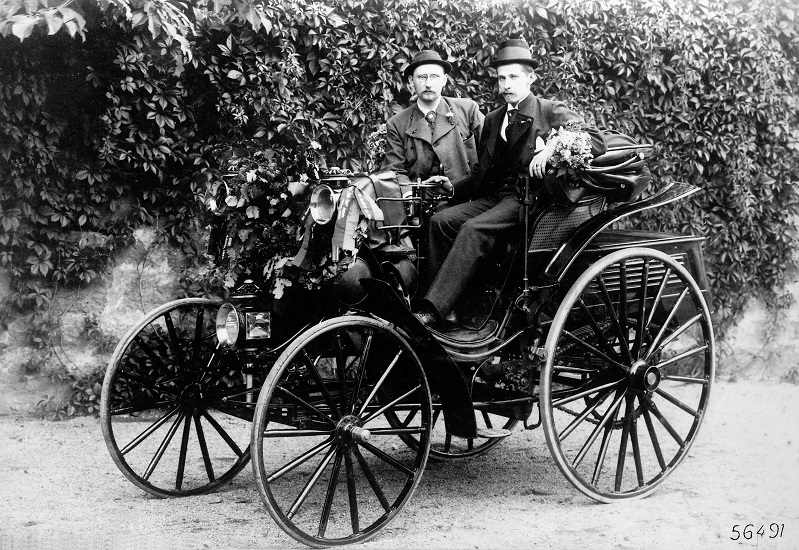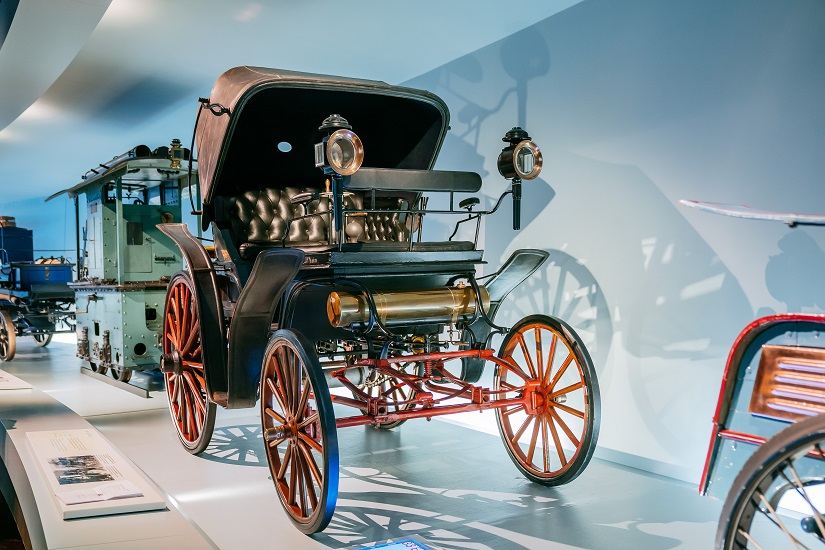
Baron Theodor von Liebieg undertook a long-distance journey from east to west in 1894
1893 premiere of production-ready double-pivot steering in the Benz Victoria
Sophisticated design for safe cornering
Visit to automobile inventor Carl Benz in Mannheim
“Close-up” – the name of this series from the Mercedes-Benz Museum says it all. Each instalment tells a surprising, exciting or behind-the-scenes story, illuminating details of a vehicle, an exhibit or an architectural or design feature. In the spotlight this time: the Benz Victoria of 1893 in the Legend Room 1: Pioneers – The Invention of the Automobile.
No. 5/2024: Benz Victoria
Adventure in the Benz Victoria: Almost one thousand kilometres by car was truly an adventure in 1894. Baron Theodor von Liebieg was equal to the challenge. He was the son of a manufacturer from Reichenberg, now Liberec in the Czech Republic, and an early customer of Carl Benz. The car he drove was a Benz Victoria. This was equipped with a pioneering innovation – double-pivot steering.
More safety and comfort: In 1893, Carl Benz developed the principle of double-pivot steering to production maturity and equipped a four-wheeled automobile with it for the first time. The new technology made driving considerably safer and more comfortable than with conventional drawbar steering. In the latter, the entire front axle swivels around a pivot point as in a horse-drawn vehicle. The risk of tipping over is particularly high on tight bends. Gottlieb Daimler and Wilhelm Maybach also developed an alternative to drawbar steering for their steel-wheeled carriage of 1889.
Pioneering innovation: In the Victoria, both front wheels were steered independently of each other and their tracks converged at the apex of the bend. This was a trailblazing innovation in the truest sense of the word. Visitors to the Mercedes-Benz Museum can see the highly innovative steering system designed by the Mannheim car inventor on the Benz Victoria of 1893 in the Legend Room 1: Pioneers – The Invention of the Automobile.
High technology with steering crank: The bodywork of the Benz Victoria resembles a coach. However, the new steering technology was a real highlight of the early automotive era. Its sophisticated design showed the way to the future. The vehicle is steered using a horizontal crank located in the centre of the vehicle on top of the vertical steering column. The steering column transmits the steering impulse to a horizontal cross-rod, which in turn moves two longitudinally arranged rods that run side by side under the vehicle body up to the front axle and move in opposite directions. At the front axle, the steering impulse is again transferred from a cross-rod to a vertical shaft. This isolates the steering from shocks imparted by the road surface, which was generally poor at the time, by means of a coil spring and a leaf spring at right angles to the direction of travel. Finally, the two track rods lead from the leaf spring to the front wheels, which are guided in a fork axle.
Early customer: Baron Theodor von Liebieg visited Carl Benz in Mannheim in 1893, was impressed by the Victoria and ordered one. It was delivered in the spring of 1894 – by rail, as was customary for such long distances at the time.
“Benz Journey” in 1894: Liebieg, just 22 years old at the time, had become fascinated by the new means of transport and wanted to use it not only in his home region. So 130 years ago, he boldly decided to undertake an almost 1,000-kilometre automobile journey to Gondorf on the Moselle.
Unique record: The Mercedes-Benz Classic archives have a valuable document covering this extraordinary journey – the original, detailed and richly illustrated diary. It provides extensive and elaborate information about the experiences of Liebieg and his companion Franz Stransky on this “Journey by Benz from Bohemia to the banks of the Moselle”, as it says on the front cover of the diary.
In the tradition of Bertha Benz: Liebieg and Stransky set off on 16 July 1894. Barely six years had passed since Bertha Benz made her first long-distance journey in an automobile. In August 1888, Carl’s wife travelled from Mannheim to Pforzheim with their two sons in a Benz Patent Motor Car Model 3, demonstrating the potential of the automobile for individual mobility.
A major challenge: There had been considerable technical improvements between 1888 and 1894, but Liebieg’s long-distance journey was still extremely demanding. This was because the roads were not designed for this innovative mode of transport, and there was still no reliable refuelling infrastructure. Motorists purchased petrol from pharmacies or chemists along the way, filling it into the shiny brass tank above the front axle. The average fuel consumption of their Benz Victoria was more than 20 litres per 100 kilometres. After six stages with a total journey time of 69 hours, they arrived in Gondorf having covered a total distance of 939 kilometres.
Well equipped: Historical photos show how similar Liebieg’s car was to the Benz Victoria on display in the Mercedes-Benz Museum. The vehicle was characterised by slim wood-spoked wheels with a smaller diameter at the front than at the rear, block brakes for deceleration, chain drive at the rear axle, a high seating position and a folding soft top. The horizontal single-cylinder engine produced 2.9 kW (4 hp) from a displacement of 1,990 cubic centimetres. The Museum exhibit, which is one year older, develops 2.2 kW (3 hp) from a displacement of 1,726 cubic centimetres. In addition, Liebieg fitted his Victoria with a third lantern at the front. The Baron’s original vehicle is now on display in the Technical Museum in Prague.
Ingenious basic principle: The young aristocrat was not only enthusiastic about technology, but also about the freedom that motorised individual mobility made possible. As he wrote in his diary: “We chose a vehicle that frees us from petty annoyances and leaves us to direct matters for ourselves. This was the petrol motor car of the ingenious Benz in Mannheim.”

Overnight stage to Mannheim: On 20 July 1894, Liebieg and his travelling companion arrived in Mannheim. This marked the end of a spectacular two-day run which included an overnight journey, by far the longest single stage of the journey. The first port of call was the birthplace of the Victoria. Theodor von Liebieg: “We immediately drove to the Benz & Cie. factory, where Mr [Friedrich] von Fischer and Mr [Carl] Benz awaited us; both were delighted with our daring endeavour and the happy outcome. After all, the car had covered 282 kilometres in the last 26 hours, a distance that no one has ever undertaken on such a vehicle[!].”
A contemporary testimony to good service: The diary from 1894 is an impressive document about early long-distance journeys by car. It also testifies to the strong service ethic at Benz & Cie.: during the stops in Mannheim on the outward and return journeys, the vehicle of Baron von Liebieg was extensively serviced. And after a breakdown during a stay of several weeks on the Moselle, where the Baron went on numerous excursions, a Benz mechanic was despatched there to carry out the necessary work.
A fond farewell: On the way back, car designer Benz and his family even escorted their customer. “On Sunday we started our journey home again, accompanied by the whole Benz family, who travelled with us as far as Gernsheim. We said our goodbyes over the last bottle of Moselle, and after photographing the two cars we drove on alone towards Offenbach.” All in all, Liebieg covered around 2,500 kilometres in his Victoria on this journey to the Moselle and back.
From long-distance driving to motorsport: The “Benz Journey” undertaken by Liebieg in 1894 was important proof that the motor car was perfectly suited to travelling very long distances. In the same year, the same idea gave rise to a new form of competition in France, namely motor racing: Vehicles with Daimler-licensed engines won the first automobile race from Paris to Rouen. This marked the beginning of 130 years of motorsport at Mercedes-Benz. Theodor von Liebieg was also involved. Among other events, he took part in the first automobile race through the Alps in 1898, and in 1899 won the first international race in Vienna with a Benz 8 hp racing car.































